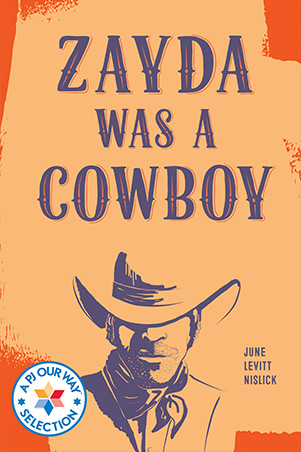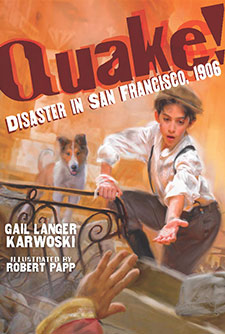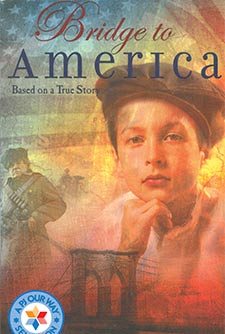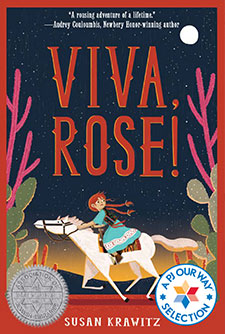Zayda Was a Cowboy
What’s a religious Russian-Jewish boy named Meyer doing in Texas? Becoming an American cowboy called Mike! Oy vey!
Average Rating
( hint: Login to leave a review! )
40 Reviews
Leave Review
What the Book is About
Jewish Content & Values
Positive Role Models
Content Advisory
Talk it Over!
More for You
What the Book is About
Meyer ben Yehezkiel’s life in a Russian shtetl is entirely bound up with Judaism and Jewish practice. When the Cossaks come, he has 24 hours to leave to avoid being conscripted into the Czar’s army. He sails for America, ends up in Texas, and finds himself gradually becoming American, and a cowboy to boot! Even when he learns to ride a horse and feed cattle, he retains his deep ties to his Jewish heritage. This sweet and fascinating story is narrated by Mike, now Zayda, in a framing narrative set in the 1980s.
An epilogue gives details of the real-life Galveston Plan, which encouraged Jewish immigrants to settle out west rather than on the east coast. There is also a reading list and a glossary that defines the book’s many Yiddish words. Zayda Was a Cowboy won the Sydney Taylor Manuscript Award in 1999.
Jewish Content & Values
- There are colorful details of life in the Russian shtetl (village) of Meyer’s birth including lessons at cheder (Hebrew school), davening (praying) at shul, and the foods eaten on Rosh Hashanah and Hanukkah.
- Zayda describes the other Jewish travelers on the boat to America and the Yiddish songs they sang, such as Tumbalalayka and Shalom Aleichem.
- Zayda peppers his conversation with Yiddish words and phrases.
- The Jewish Immigrants Information Bureau, the local synagogue, and the Jewish Welfare Society of Galveston, Texas, give the new immigrants practical help in finding work and a generous financial gift to help them get settled in the United States.
Positive Role Models
Meyer/Mike is a religious boy who tries his best to keep kosher while leading the life of an itinerant cowboy. In one beautiful passage he speaks of welcoming the Shabbos Bride in his heart, and of his yearning for “a minyan, a few words of Torah, being with my own people.”
Content Advisory
In one paragraph, Zayda gives details of how the cattle were branded. He explains why it was a necessary practice but acknowledges that it sounds like a terrible thing to do and admits that he himself is not sure whether he believes the view that the animals did not feel pain. The description of branding is short but may upset sensitive readers.
Talk it Over!
Many of the Jewish workers immigrating to the mid-west and west in the early 20th century were religious back in Eastern Europe, but it was difficult or even impossible to observe Shabbat in these small American towns, where there were few Jews and people worked on Saturdays. What do you think you would have done if you were an immigrant in this situation?
More for You
The Galveston Plan was set up by German-Jewish businessmen in New York, notably Jacob Schiff, with the aim of helping Jews immigrate to the United States without increasing the burden on Jewish charities on the east coast. The original intention was to bring 250,000 Jews out of Eastern Europe to settle in the West and Midwest, but the plan came to an end when World War I broke out in 1914. Nevertheless, 10,000 Jewish immigrants came through Galveston, with most of them moving on to 100 different locations.
What the Book is About
What the Book is About
Meyer ben Yehezkiel’s life in a Russian shtetl is entirely bound up with Judaism and Jewish practice. When the Cossaks come, he has 24 hours to leave to avoid being conscripted into the Czar’s army. He sails for America, ends up in Texas, and finds himself gradually becoming American, and a cowboy to boot! Even when he learns to ride a horse and feed cattle, he retains his deep ties to his Jewish heritage. This sweet and fascinating story is narrated by Mike, now Zayda, in a framing narrative set in the 1980s.
An epilogue gives details of the real-life Galveston Plan, which encouraged Jewish immigrants to settle out west rather than on the east coast. There is also a reading list and a glossary that defines the book’s many Yiddish words. Zayda Was a Cowboy won the Sydney Taylor Manuscript Award in 1999.
Jewish Content & Values
Jewish Content & Values
- There are colorful details of life in the Russian shtetl (village) of Meyer’s birth including lessons at cheder (Hebrew school), davening (praying) at shul, and the foods eaten on Rosh Hashanah and Hanukkah.
- Zayda describes the other Jewish travelers on the boat to America and the Yiddish songs they sang, such as Tumbalalayka and Shalom Aleichem.
- Zayda peppers his conversation with Yiddish words and phrases.
- The Jewish Immigrants Information Bureau, the local synagogue, and the Jewish Welfare Society of Galveston, Texas, give the new immigrants practical help in finding work and a generous financial gift to help them get settled in the United States.
Positive Role Models
Positive Role Models
Meyer/Mike is a religious boy who tries his best to keep kosher while leading the life of an itinerant cowboy. In one beautiful passage he speaks of welcoming the Shabbos Bride in his heart, and of his yearning for “a minyan, a few words of Torah, being with my own people.”
Content Advisory
Content Advisory
In one paragraph, Zayda gives details of how the cattle were branded. He explains why it was a necessary practice but acknowledges that it sounds like a terrible thing to do and admits that he himself is not sure whether he believes the view that the animals did not feel pain. The description of branding is short but may upset sensitive readers.
Talk it Over!
Talk it Over!
Many of the Jewish workers immigrating to the mid-west and west in the early 20th century were religious back in Eastern Europe, but it was difficult or even impossible to observe Shabbat in these small American towns, where there were few Jews and people worked on Saturdays. What do you think you would have done if you were an immigrant in this situation?
More for You
More for You
The Galveston Plan was set up by German-Jewish businessmen in New York, notably Jacob Schiff, with the aim of helping Jews immigrate to the United States without increasing the burden on Jewish charities on the east coast. The original intention was to bring 250,000 Jews out of Eastern Europe to settle in the West and Midwest, but the plan came to an end when World War I broke out in 1914. Nevertheless, 10,000 Jewish immigrants came through Galveston, with most of them moving on to 100 different locations.




